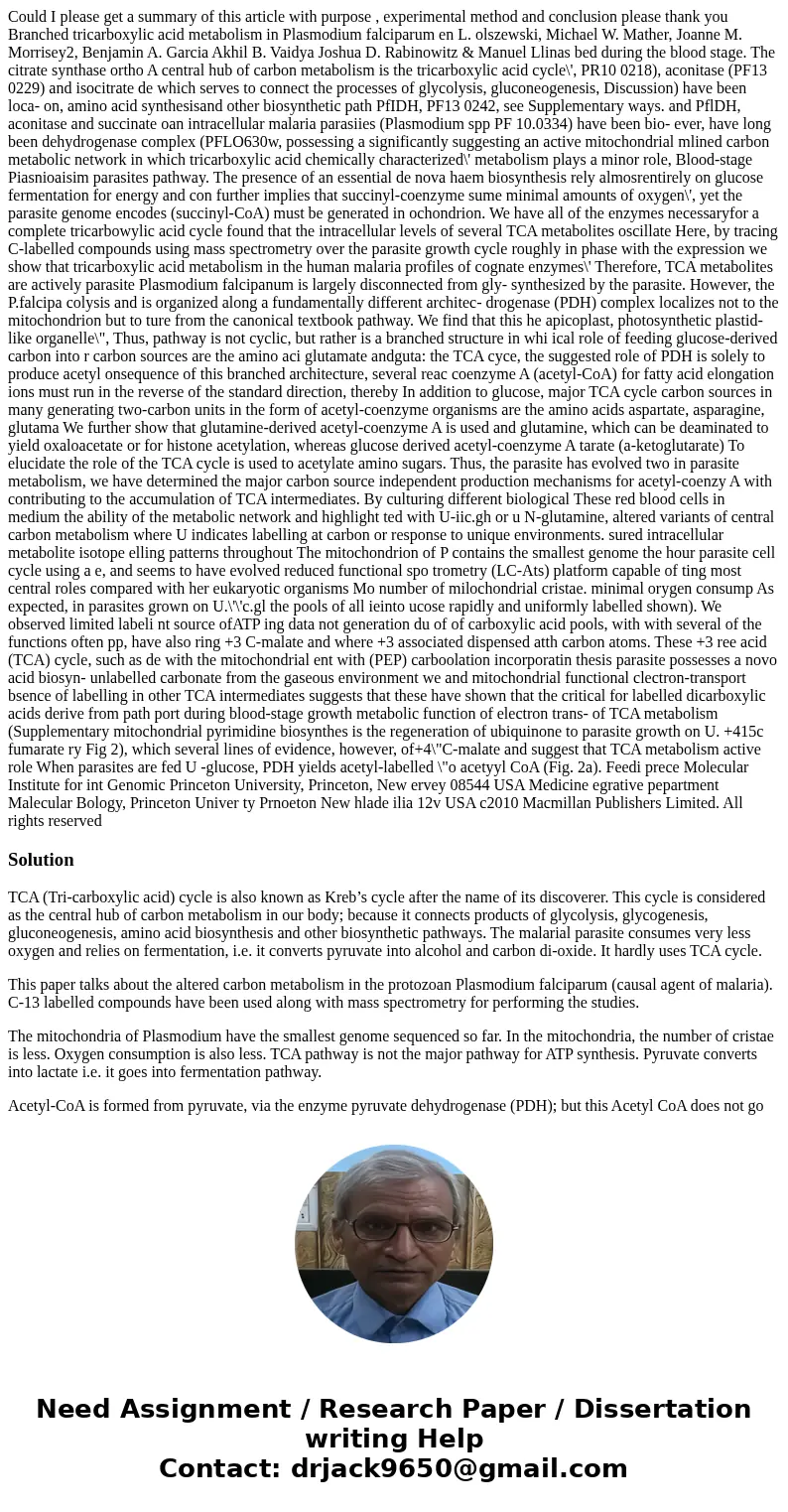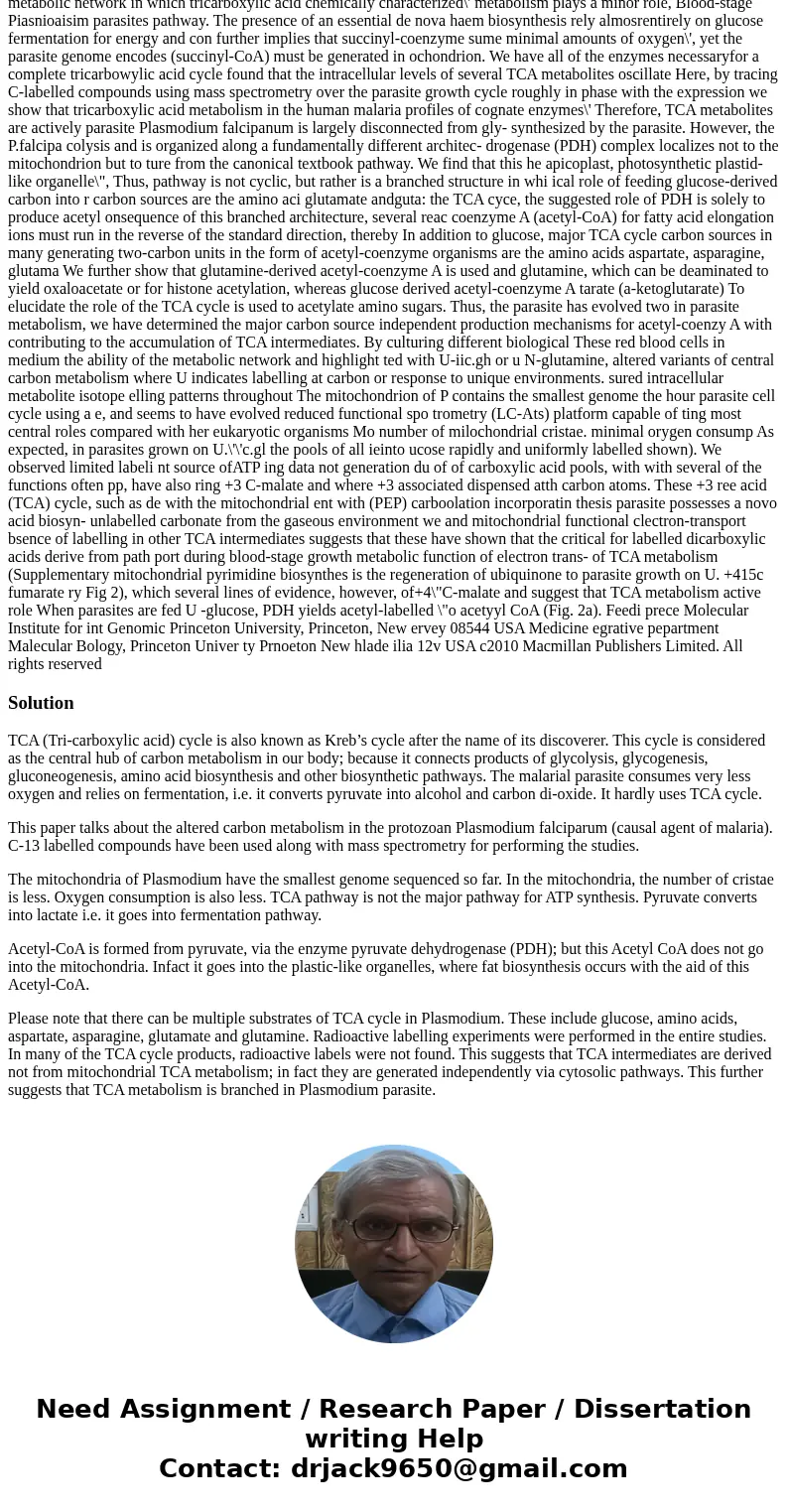Could I please get a summary of this article with purpose , experimental method and conclusion please thank you
Branched tricarboxylic acid metabolism in Plasmodium falciparum en L. olszewski, Michael W. Mather, Joanne M. Morrisey2, Benjamin A. Garcia Akhil B. Vaidya Joshua D. Rabinowitz & Manuel Llinas bed during the blood stage. The citrate synthase ortho A central hub of carbon metabolism is the tricarboxylic acid cycle\', PR10 0218), aconitase (PF13 0229) and isocitrate de which serves to connect the processes of glycolysis, gluconeogenesis, Discussion) have been loca- on, amino acid synthesisand other biosynthetic path PfIDH, PF13 0242, see Supplementary ways. and PflDH, aconitase and succinate oan intracellular malaria parasiies (Plasmodium spp PF 10.0334) have been bio- ever, have long been dehydrogenase complex (PFLO630w, possessing a significantly suggesting an active mitochondrial mlined carbon metabolic network in which tricarboxylic acid chemically characterized\' metabolism plays a minor role, Blood-stage Piasnioaisim parasites pathway. The presence of an essential de nova haem biosynthesis rely almosrentirely on glucose fermentation for energy and con further implies that succinyl-coenzyme sume minimal amounts of oxygen\', yet the parasite genome encodes (succinyl-CoA) must be generated in ochondrion. We have all of the enzymes necessaryfor a complete tricarbowylic acid cycle found that the intracellular levels of several TCA metabolites oscillate Here, by tracing C-labelled compounds using mass spectrometry over the parasite growth cycle roughly in phase with the expression we show that tricarboxylic acid metabolism in the human malaria profiles of cognate enzymes\' Therefore, TCA metabolites are actively parasite Plasmodium falcipanum is largely disconnected from gly- synthesized by the parasite. However, the P.falcipa colysis and is organized along a fundamentally different architec- drogenase (PDH) complex localizes not to the mitochondrion but to ture from the canonical textbook pathway. We find that this he apicoplast, photosynthetic plastid-like organelle\", Thus, pathway is not cyclic, but rather is a branched structure in whi ical role of feeding glucose-derived carbon into r carbon sources are the amino aci glutamate andguta: the TCA cyce, the suggested role of PDH is solely to produce acetyl onsequence of this branched architecture, several reac coenzyme A (acetyl-CoA) for fatty acid elongation ions must run in the reverse of the standard direction, thereby In addition to glucose, major TCA cycle carbon sources in many generating two-carbon units in the form of acetyl-coenzyme organisms are the amino acids aspartate, asparagine, glutama We further show that glutamine-derived acetyl-coenzyme A is used and glutamine, which can be deaminated to yield oxaloacetate or for histone acetylation, whereas glucose derived acetyl-coenzyme A tarate (a-ketoglutarate) To elucidate the role of the TCA cycle is used to acetylate amino sugars. Thus, the parasite has evolved two in parasite metabolism, we have determined the major carbon source independent production mechanisms for acetyl-coenzy A with contributing to the accumulation of TCA intermediates. By culturing different biological These red blood cells in medium the ability of the metabolic network and highlight ted with U-iic.gh or u N-glutamine, altered variants of central carbon metabolism where U indicates labelling at carbon or response to unique environments. sured intracellular metabolite isotope elling patterns throughout The mitochondrion of P contains the smallest genome the hour parasite cell cycle using a e, and seems to have evolved reduced functional spo trometry (LC-Ats) platform capable of ting most central roles compared with her eukaryotic organisms Mo number of milochondrial cristae. minimal orygen consump As expected, in parasites grown on U.\'\'c.gl the pools of all ieinto ucose rapidly and uniformly labelled shown). We observed limited labeli nt source ofATP ing data not generation du of of carboxylic acid pools, with with several of the functions often pp, have also ring +3 C-malate and where +3 associated dispensed atth carbon atoms. These +3 ree acid (TCA) cycle, such as de with the mitochondrial ent with (PEP) carboolation incorporatin thesis parasite possesses a novo acid biosyn- unlabelled carbonate from the gaseous environment we and mitochondrial functional clectron-transport bsence of labelling in other TCA intermediates suggests that these have shown that the critical for labelled dicarboxylic acids derive from path port during blood-stage growth metabolic function of electron trans- of TCA metabolism (Supplementary mitochondrial pyrimidine biosynthes is the regeneration of ubiquinone to parasite growth on U. +415c fumarate ry Fig 2), which several lines of evidence, however, of+4\"C-malate and suggest that TCA metabolism active role When parasites are fed U -glucose, PDH yields acetyl-labelled \"o acetyyl CoA (Fig. 2a). Feedi prece Molecular Institute for int Genomic Princeton University, Princeton, New ervey 08544 USA Medicine egrative pepartment Malecular Bology, Princeton Univer ty Prnoeton New hlade ilia 12v USA c2010 Macmillan Publishers Limited. All rights reserved
TCA (Tri-carboxylic acid) cycle is also known as Kreb’s cycle after the name of its discoverer. This cycle is considered as the central hub of carbon metabolism in our body; because it connects products of glycolysis, glycogenesis, gluconeogenesis, amino acid biosynthesis and other biosynthetic pathways. The malarial parasite consumes very less oxygen and relies on fermentation, i.e. it converts pyruvate into alcohol and carbon di-oxide. It hardly uses TCA cycle.
This paper talks about the altered carbon metabolism in the protozoan Plasmodium falciparum (causal agent of malaria). C-13 labelled compounds have been used along with mass spectrometry for performing the studies.
The mitochondria of Plasmodium have the smallest genome sequenced so far. In the mitochondria, the number of cristae is less. Oxygen consumption is also less. TCA pathway is not the major pathway for ATP synthesis. Pyruvate converts into lactate i.e. it goes into fermentation pathway.
Acetyl-CoA is formed from pyruvate, via the enzyme pyruvate dehydrogenase (PDH); but this Acetyl CoA does not go into the mitochondria. Infact it goes into the plastic-like organelles, where fat biosynthesis occurs with the aid of this Acetyl-CoA.
Please note that there can be multiple substrates of TCA cycle in Plasmodium. These include glucose, amino acids, aspartate, asparagine, glutamate and glutamine. Radioactive labelling experiments were performed in the entire studies. In many of the TCA cycle products, radioactive labels were not found. This suggests that TCA intermediates are derived not from mitochondrial TCA metabolism; in fact they are generated independently via cytosolic pathways. This further suggests that TCA metabolism is branched in Plasmodium parasite.


 Homework Sourse
Homework Sourse